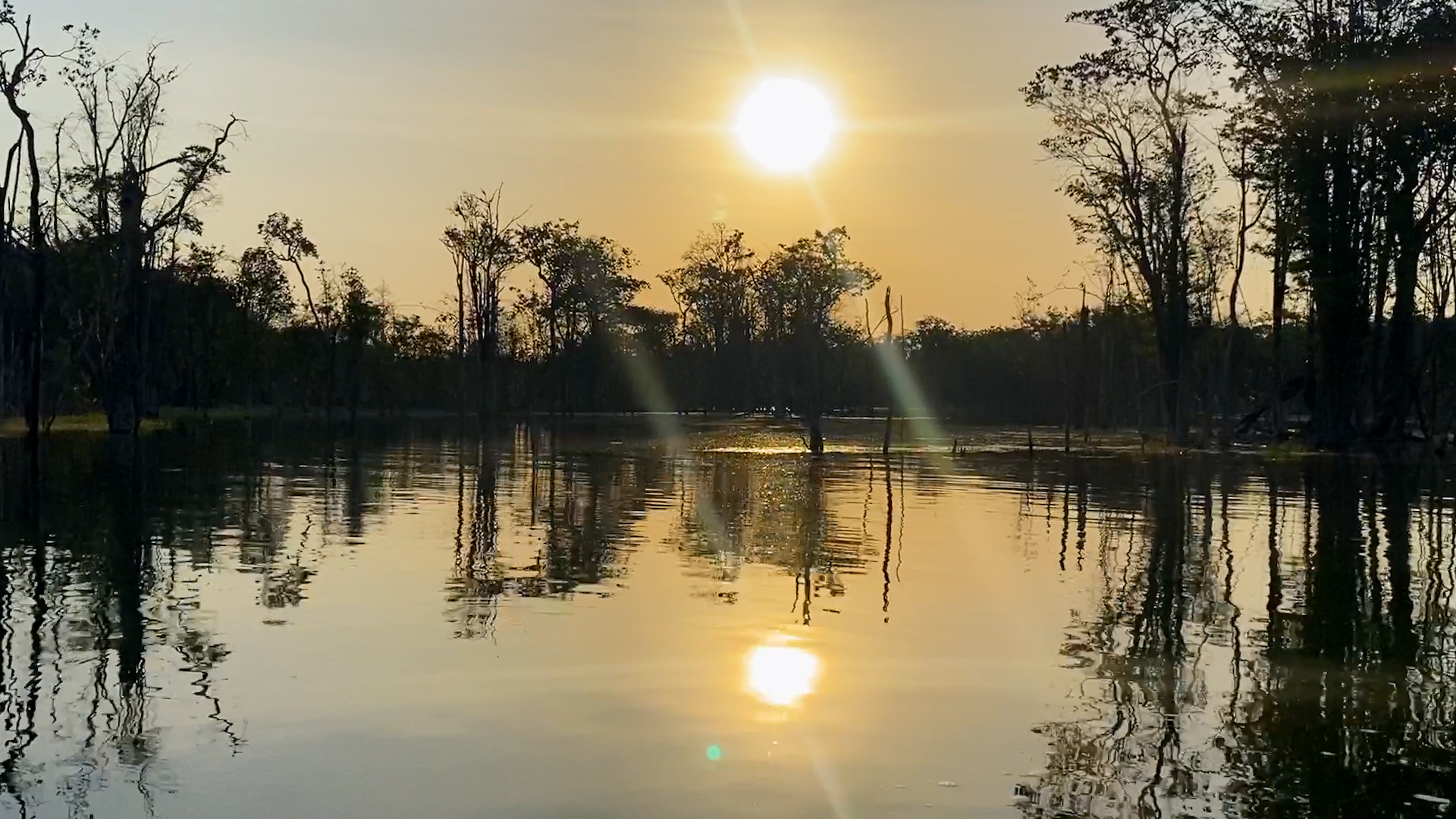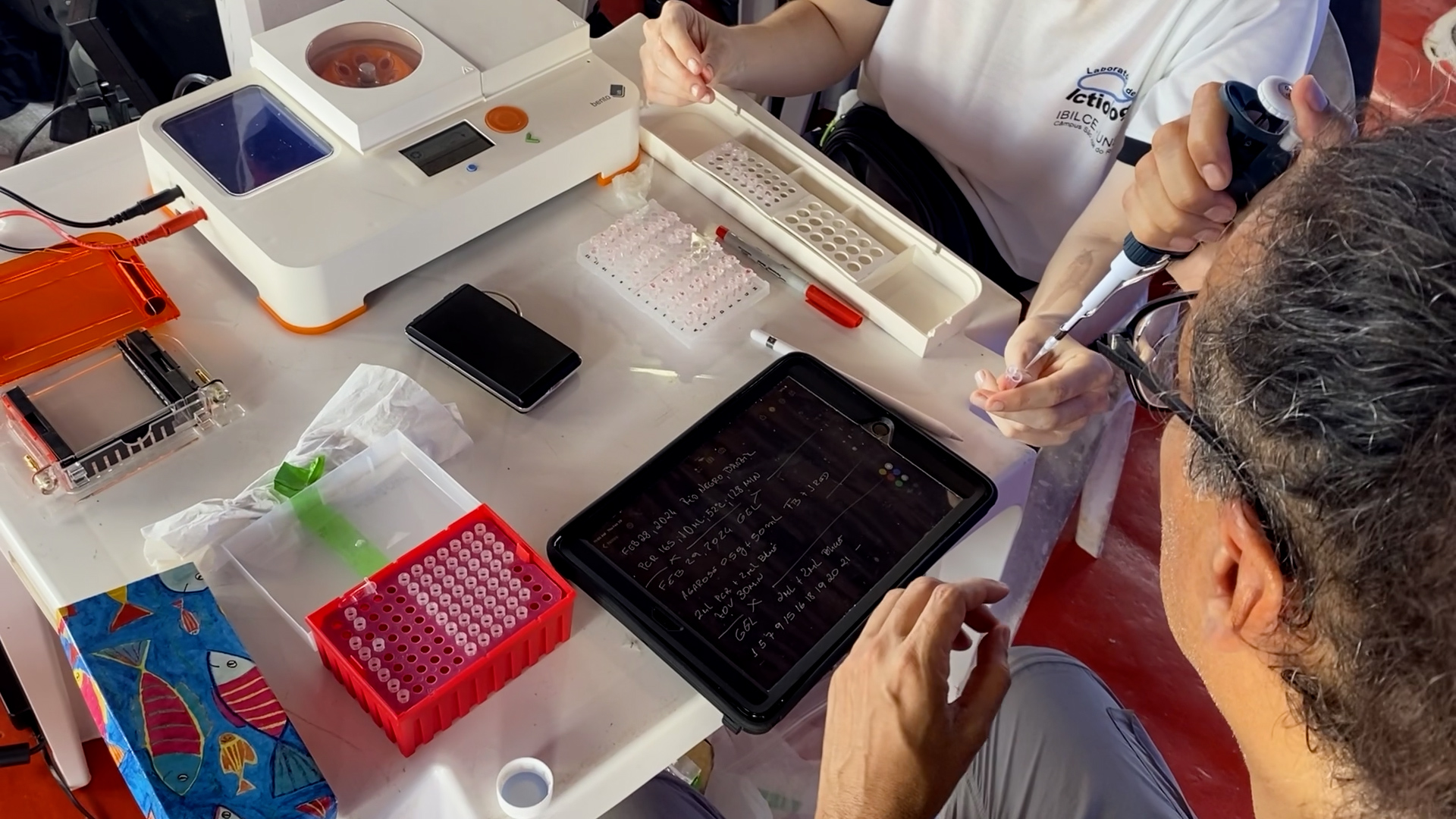

DEGy Negro River Expedition team, including researchers, crew and members of Agência FAPESP (photo: Phelipe Janning/Agência FAPESP)
The last episode of the series of reports takes stock of the journey of a group of researchers from the USP Museum of Zoology, who spent two weeks traveling along the Negro, Preto and Jauaperi rivers in the states of Amazonas and Roraima.
The last episode of the series of reports takes stock of the journey of a group of researchers from the USP Museum of Zoology, who spent two weeks traveling along the Negro, Preto and Jauaperi rivers in the states of Amazonas and Roraima.

DEGy Negro River Expedition team, including researchers, crew and members of Agência FAPESP (photo: Phelipe Janning/Agência FAPESP)
By André Julião and Phelipe Janning | Agência FAPESP – At least 136 species of fish were collected during the two-week DEGy Negro River Expedition, which traveled up the river from Manaus to Santa Isabel do Rio Negro, passing through the Jauaperi and Preto tributaries. Agência FAPESP followed the entire trip, which took place in February and resulted in the Field Diary – Negro River series.
There were 27 species of Gymnotiformes alone, the order comprising electric fish that give its name to the project supported by FAPESP, under which the expedition took place.
In addition to this group, at least 48 species of Characiformes, such as lambaris; 40 of Siluriformes, the catfish group; seven of Cichlids, such as tucunaré; six of rays (Potamotrygonidae) and nine of other orders were collected during the trip. However, this number could increase.
“The number may be underestimated because there are many fish in the Characiformes order that were not identified in the field due to the difficulty of distinguishing one species from another. It’s possible that we’ve reached something like 150 species,” explains Osvaldo Oyakawa, a research support technician at the Museum of Zoology of the University of São Paulo (MZ-USP), who coordinated the collections.
In addition to the lambaris, there is at least one electric fish and one ray whose identity is not entirely clear to the researchers. The differences found may be variations within already described species or new species.
“An expedition always produces important results, both for the project under development and for the graduate students. This one was no exception. Although the fish collected haven’t yet been examined in detail by the researchers, it was possible to conclude that some new species have been obtained to scientifically enrich the ongoing projects,” concludes Naércio Menezes, professor at MZ-USP, who coordinates the project.
One type of analysis that could clear up doubts is genetic sequencing. To do this, the researchers took tissue samples that were preserved in alcohol and then had the DNA extracted. Then, some genes of interest are amplified and finally sequenced. This part of the work will be carried out in São Paulo and has yet to be defined.

Late afternoon in an igarapé that flows into the Jauaperi River: water bodies like this, but also large rivers, were sampled by the researchers (photo: Phelipe Janning/Agência FAPESP)
Accelerating discoveries
During the expedition, Carlos David de Santana, a researcher associated with the Smithsonian Institution’s National Museum of Natural History in the United States, in partnership with the company Bento Lab, tested for the first time in the Amazon a procedure that could speed up this process.
Using a device, the researchers extracted DNA and amplified genes of interest while still in the field. These are two steps before sequencing, which identifies the species at a molecular level.
“In a context of rapid biodiversity reduction like the one we’re experiencing, it’s urgent to reduce the time between collecting specimens and publishing the results. That’s why devices like this can speed up the description of new species by bringing genetic material from the field ready for sequencing in the lab, or even already sequenced,” says Santana.
The British-made device, weighing 3.5 kilos, fits into a laptop bag and plugs into a standard socket. One of its secrets is that it requires fewer steps than equipment normally found in laboratories.
“With the equipment, it’s possible to extract DNA and amplify the fragments you want to study, reducing and optimizing the steps that would normally be done in the laboratory, thus reducing the procedure time in the field and in the laboratory,” adds Laura Donin, a doctoral student at MZ-USP who participated in the expedition.

David de Santana and Laura Donin perform DNA extraction and gene amplification on board the Comandante Gomes (photo: Phelipe Janning/Agência FAPESP)
Sequencing in the field would be possible with other portable equipment, which was not available on the expedition.
Santana believes that in a few years, such devices will be available to more people at more affordable prices. As a result, communities and universities far from major centers will be able to conduct their own surveys of local biodiversity, including genetic data.
“With satellite internet becoming popular in the Amazon, these data could be transmitted anywhere in the world. It would be possible to increase knowledge about the species in a much shorter time without necessarily relying on costly expeditions like this one,” says Santana.
Unintentional collection
It is the middle of the night of February 27 when Oyakawa, fisherman Roberval Ribeiro and master’s student Vinicius Cardoso board the boat for the last bottom trawl of the expedition on the Preto River.
At night, many species migrate from the channel to the river banks, increasing the researchers’ chances of collecting them. The boat is slowly pulling in the net when some fish simply start jumping into the boat.
“They were probably escaping from an alligator or a porpoise and ended up on the boat,” explains Oyakawa, surprised by the unintentional collection. Quite a close call for a fish-collecting expedition.

Team during the last bottom trawl of the expedition. Fish jumped into the boat (photo: Phelipe Janning/Agência FAPESP)
The next day, some of the nets left the night before are collected and the Comandante Gomes heads downriver towards Barcelos, the last stop before Manaus. The boat docks at the Port of Panair in the middle of the morning of March 2, a Saturday.
A truck from the National Institute for Amazonian Research (INPA) awaits the team, who quickly unloads the collected material and equipment. Gradually, everyone gets into cars and heads for the hotels where they will stay for the weekend. On Monday, everyone will be at INPA, preparing the material to be sent to the USP Museum of Zoology. It is the end of the DEGy Negro River Expedition.
“The students had a valuable experience as they became familiar with methods of collecting specimens and with the unique aquatic environments of the Amazon. The efforts of the entire team that participated in the expedition were well rewarded by the results obtained,” concludes Menezes.

Roberval Ribeiro and Osvaldo Oyakawa check the last waiting nets before the end of the expedition (photo: Phelipe Janning/Agência FAPESP)
Sharing the results
Given the large number of records made during the expedition, Agência FAPESP, the Ichthyology Laboratory and the Cultural Dissemination Division of the USP Museum of Zoology will prepare an exhibition on the DEGy Negro River Expedition. The temporary exhibition should open at the end of 2024.
“This is yet another development in the rich partnership between MZ-USP and Agência FAPESP. Even with the end of the Field Diary series, we don’t (yet) have to regret the end of our work together,” says Murilo Pastana, professor at MZ-USP.
Reflections
Before the DEGy Negro River Expedition actually began, most of the material was prepared at the USP Museum of Zoology and shipped to Guarulhos International Airport. Other equipment and supplies were distributed between Inpa and the Federal University of Amazonas (Ufam) (read more at: agencia.fapesp.br/51872).
On February 19, with the entire team assembled, the Comandante Gomes left the Port of Panair in Manaus for the Jauaperi River. In this tributary, the team made its first collections. At this point in the journey, the main objective was to collect specimens of Iracema caiana, an electric fish collected there in 1968 and never seen again in the wild. There was no success in this particular endeavor, perhaps due to the historic drought in the region (read more at: agencia.fapesp.br/51873).
The most famous of the electric fish, the poraquês, thrive in the Preto River. In just one creek, there is a veritable “condominium” of these animals, which can measure up to 2.5 meters (read more at: agencia.fapesp.br/51874).
However, the sarapós are the most abundant electric fish and occupy the most habitats. During the expedition, 27 species were collected in two weeks (read more at: agencia.fapesp.br/51876).
Every expedition has its setbacks, but even an accident with a ray that could have been serious did not slow the pace of the collections (read more at: agencia.fapesp.br/51879).
In difficult times like these, friends and memories of other expeditions can be an antidote. In DEGy Negro River, four members had many stories to share from Calhamazon, a 1990s project that pioneered bottom trawling in rivers ideal for collecting electric fish (read more at: agencia.fapesp.br/51887).

Full moon on the Negro River: expedition ends with more than 130 species collected, some possibly never described (photo: Phelipe Janning/Agência FAPESP)
All the episodes of Field Diary – Negro River can be viewed at: agencia.fapesp.br/en/field-diary.
Republish
The Agency FAPESP licenses news via Creative Commons (CC-BY-NC-ND) so that they can be republished free of charge and in a simple way by other digital or printed vehicles. Agência FAPESP must be credited as the source of the content being republished and the name of the reporter (if any) must be attributed. Using the HMTL button below allows compliance with these rules, detailed in Digital Republishing Policy FAPESP.





